All published articles of this journal are available on ScienceDirect.
Effectiveness of the Program of Enhancing the Imagination by Use of a Mobile App on Easing Nursing-Student Stress Loads
Abstract
Background:
Stress constitutes an obstacle to problem-solving and decision-making skills, particularly among nursing students. Most of their coursework is essential for their entry into the practice of nursing and gaining access to their patients. Stress management through the enhancement of imagination, coupled with a cognitive and behavioral-therapy program using a mobile-phone application, are at the core of the present study.
Objective:
The purpose of this study was to evaluate the effectiveness of using a stress management technique in enhancing the imagination of nursing students through the use of a mobile app on easing their stress loads.
Methodology:
The present study is an experimental research and involves 54 nursing students, subdivided into two groups using the repeated measures design. It consists of pre-experimentation, where their imagination enhancement is focused on the topic of stress relief. The nursing students practice the enhancement exercises on their own for approximately 10 minutes each time and every day for 14 days, with an immediate post-experiment and a two-week post-experiment follow-up. The two groups involved were the group whose members used the program for enhancing their imagination through the use of a mobile app, and the group whose members were counseled by their instructors through a stress-assessment device known as the Thai Stress Test.
Results:
The results were based on the measurements of stress that was induced by negative thought anxiety during three time frames: (1) prior to entering the program; (2) at the conclusion of the program; and (3) two weeks after the program conclusion. It was found that the average stress values of the two groups at each of these times differed with a statistical significance of 0.05. In time frame (2), the combined score of the control group was higher than that of the experimental group; and in the experimental group, stress levels decreased after using the enhancing techniques shown in the imagination app.
Conclusion:
The application of the technology used in this study in the imagination-enhancement program for stress reduction was found to be appropriate for the context of the target group, whose members were in their adolescence. It proved to be a method of easing their stress, unlimited by either time or place. As a result, the program can be effectively used to reduce the stress burden borne by students.
1. BACKGROUND AND SIGNIFICANCE OF THE STUDY
Nursing students are typically provided a nursing syllabus that requires study or training, as well as professional values and ethics. This means working independently and persistently, with full dedication toward the profession [1], and with credible legal autonomy. The nursing profession refers to a career of service, responding to the health needs of society at the level of the individual, the family, and the community, in scenarios of both sound health and illnesses [2]. The objectives of the nursing profession consist in the provision of care, assistance, rehabilitation, disease prevention, and the promotion of health, including assisting a physician in the treatment of disease, all of which depend on the application of specialized nursing knowledge [3]. In studying for the nursing profession in Thailand, students begin their practice during the second semester of their second year of undergraduate education and continue to practice in their third and fourth year. The students practice three days a week in a hospital [4]. After high school students have graduated, they can apply to nursing school, where they will study basic science, for example fundamental anatomy and fundamental biochemistry in the first year. In the second year, the nursing students have to continue to study basic nursing science during the first semester and practice the fundamentals of nursing with patients in the hospital during the second semester. The third year, they begin to study and practice specific areas of nursing science, such as mental health and psychiatric nursing, community health nursing, and nursing for the family and midwifery. At the end of their studies, fourth-year students practice in the hospital more than they study in the classroom and must pass nursing competency assessment and a licensing examination [5].
Stress poses an obstacle to concentration in problem solving and decision-making, and obstructs other necessary abilities and is thus a serious factor in terms of students’ learning [6]. There is now evidence that makes it unmistakably clear that students are under a great deal of stress from their programs of study in the health professions, which can adversely affect their health as they study [7]. As an example, it has been found that more than half of clinical-class nursing students between their second and fourth years of study are severely stressed. Nonetheless, it has been found that 24.5% of students with scores at an abnormal level from screening were suffering from depression [8]. Furthermore, it has been found that nearly one in every three students enrolled in the public-health sciences have moderate stress levels [9]. As regards those students that are studying in the nursing professions, it has been found that they experience stress levels at a higher level than students enrolled in other branches of the health sciences [10]. In fact, it has been suggested that the stress imposed on nursing students in many universities is greater than the stress borne by all other university students [11]. In addition, it has been found that some nursing students, third-year nursing students in particular, time to time have had to deal with a lot of problems that impact their mental health [12]. Further, studies of the stresses imposed upon first-year nursing students have shown that these students experience high stress levels. The same studies also show that the stress borne by nursing students is not related to the methods of stress management currently being used [13]. A possible explanation is that those with high stress levels are continuing to use methods of stress management that are inappropriate, so that they are not able to manage their stress as much as they should. Consequently, their stress levels remain high. Students that use proper problem-solving methods, on the other hand, succeed in reducing their stress loads. These outcomes are in agreement with a previous study, in which it was found that student stress was not related to confronting stress [14].
There are many causes of stress in nursing students. From a study conducted by Shaban et al. [15] it was found that the causes of stress in nursing students were rooted in their learning environment, especially in the work that was being assigned to them in the various subject areas of their study. As regards the cause of stress in Thai nursing students, it was found that it was their nursing coursework, and especially courses in the practice of nursing that were creating this stress [16]. These students did not yet understand the system of work applicable to the field of nursing; nonetheless, they were being quizzed by their instructors to determine how much they knew already. This impact was being especially felt by nursing students that were entering the field of practical nursing for the first time [17]. It was found that there was stress from performing procedures and becoming prepared with the necessary knowledge for use in the patient wards. They felt stressed from the patient-ward environment and from their need to connect and communicate with the senior nurses, and the patients and relatives of the patients. They were forced to endure stress from having the role of instructor in the patient wards and from the effect it was having on their own states of health and on their living [18].
There are many ways to reduce stress. In one study, it was found that enhancing the imagination took place in conjunction with a cognitive and behavioral-therapy program, in which it was found that there are many ways of easing stress, each of which can effectively lower the stress load being borne by an individual [19]. Imagination uses the ability of the subconscious to imagine for example a peaceful natural fantasy or natural images where the practitioner finds herself or himself in a relaxing and peaceful body. While imagining images, the practitioner should breathe evenly and deeply, and focus on the details of the images created, such as their colors, sizes, texture, sounds, odors, and surroundings. When other ideas interfere, the practitioner should draw her or his attention back to those details [20]. Sriwatanakul [21] stated that relaxation through the use of imagination techniques (autogenic training) is an applied science derived from the principle of hypnosis of Dr. Schultz, which he first developed in 1932. It is useful for improving concentration and memory, increasing the efficiency of work, and limiting worry and anxiety. Similarly, Ruchiwit [22] stated that the imagination is important and influences the control of our feelings and behaviors in carrying out our daily lives. Our thoughts and imaginations are factors that stimulate our emotions. Our imaginations are creative and can quell our emotions and make us feel comfortable. Emotional stress energy flows with ease, helping the muscles in all of the organs to relax so that a state of calm or relief can then follow, making the body ready to adopt any of various recommendations. Similarly, Saengduenchai [23] stated that methods of mind training and meditation practice should be applied for use in cognitive and behavioral therapy in order to encourage awareness of one’s thoughts and problem-solving ability based on the use of the mind. Such methods have an important use in the cognitive and behavioral adjustment of a person, causing a person to acquire a degree of behavioral durability [24]. The various methods of relaxation, including muscle relaxation, enhancing the imagination, meditation practice, etc., help to abate the tenseness of the emotions within the central nervous system and induce the limbic brain system to become less stimulated. Emotional stress is thus reduced. The affected individual then feels better, both psychologically and physically. This can be accomplished conveniently and without expense [25].
In addition, enhancing the imagination is a traditional method to reduce stress when facing individuals or groups. However, the COVID-19 pandemic has affected a variety of social causes and many countries have decided to temporarily close schools, affecting millions of students [26]. In Thailand, the government’s Department of Education has come up with guidelines to implement online and modular distance learning delivery of instruction. Moreover, according to one study, Internet usage was proportionately higher in the teenage and young-adult group, who were 15-24 years of age, than in any other group and this increased from 39.7% in 2007 to 51.9% in 2011 [27]. According to these statistics, smart phones are an important convenience for nursing students 18 to 22 years of age in their day-to-day living; their phones for example can load the imagination-enhancement app [28].
2. OBJECTIVE
The objective of the present study was to investigate the effectiveness of a program for enhancing the imagination through the use of a mobile app in order to ease nursing students’ stress loads.
2.1. Conceptual Framework of the Research
From studies conducted and theory and documented research that were relevant to this study, it was possible to examine the influence of the stress-management program on nursing students. The program was based on enhancing one’s imagination to the point of relaxation through the use of imagination techniques. The conceptual framework of the research is illustrated in Fig. (1).

3. METHODOLOGY
This study on the effect of a program for imagination enhancement through use of a mobile app on the stress loads of nursing students took the form of an experimental research, which was carried out with two groups and using a repeated measures design at each of three stages, namely, pre-experimentation, immediate post-experimentation, and two-weeks post-experimentation. The participants were subdivided into an experimental group, which took part in the imagination enhancing program through the use of a mobile app, and a control group, which received an information sheet on stress management from the mental health clinic of Thammasat University Hospital.
3.1. Research Population and Samples
The population consisted of nursing students that were in their second to fourth years of undergraduate study in 2018. They ranged in age from 18 to 24 years, comprised of 420 nursing students studying in the Faculty of Nursing at Thammasat University. The inclusion criteria required that they have low stress scores as measured by the Thai Stress Test of Phattharayuttawat et al. This research and all informed consent sheets were approved by the Human Research Ethics Committee of Thammasat University (Science Panel) (HREC-TUSc).
3.1.1. Inclusion Criteria
The Thai Stress Test is intended for mild stress levels (positive feeling scores of 3-32, negative feeling scores 0-7). The informed consent sheets provided information on this research to those nursing students whose stress levels matched the specified criteria. Volunteers were notified of the nature of the research program in which they would be participating.
3.1.2. Exclusion Criteria
Nursing students got a score greater than 24 (no depression) on the health-related self-reported [HRSR] scale of the diagnostic screening test for depression in the Thai Population and a previous diagnosis of one or more psychiatric disorders. They received counseling from a psychotherapist in the Department of Medicine at Thammasat University Hospital.
3.1.3. Sampling Design
The sample size was determined using the G*Power program version 2.9.1.3 resulting in 41 students. Moreover, this figure was increased by 35% for the drop-out (attrition) rate during the research so the sample size was 56 students. Simple random sampling was used to subdivide the participants into two groups of 28 persons each. There was one missing sample in each group; hence the final samples were 27 in each group.
- The experimental group was assigned a username and password for entry into the program for the enhancement of imagination through a mobile app. Their imagination enhancement would focus on the topic of stress relief, which they would practice on their own for approximately 10 minutes each time every day for 14 days.
- The control group received conventional mental healthcare from the mental health clinic of Thammasat University Hospital. Researchers handed out printed information on self-care in the event of stress. The reason for administering more than the usual care was that the sample group whose members were under stress at any level, from minimal to severe, must get help during the beginning stages. Additionally, in those stress cases that are further aggravated by depression, treatment must be coordinated with their guardian overseers. After the fourth week following the completion of the program on enhancing the imagination, the researchers could then decide to have the participants enter the mobile app imagination-enhancement program. Their decision depended on whether the control group was willing to participate as the experimental group. If they showed high levels of stress, they would receive counseling from a psychotherapist from the mental health clinic of Thammasat University Hospital.
3.2. Research Instruments
The present research incorporated the use of two instruments, namely, the instrument used in conducting the tests and the instrument used in compiling the data. They are as follows.
3.3. The Instrument used in Conducting the Tests
The program for enhancing imagination was developed by the researchers and validated by a specialist in mental health nursing. The use of a mobile app was developed using techniques and imagination in order to stimulate an emotional state and to induce change in the muscular system. Enhancing the imagination provides a release for the emotions and a pleasant feeling, and as stated earlier. An audio recording was made of the imagination-enhancement program and was installed in the Mind-Counseling application using the following procedure.
Quality monitoring of the imagination-training program using the mobile application included determination of its content validity by three qualified persons: two psychiatric nursing instructors and one educational technology expert. The determined index of item-objective congruence (IOC) of 0.82-1.00 met the accepted criterion of 0.50 or higher [29]. Recommendations by the qualified persons were implemented for improvement and were tried out.
How to practice program enhancing the imagination by the Mind-Counseling application
1. Install the Mind-Counseling application in the mobile devices of the volunteer participants in the experimental group, using both the iOS and Android operating systems.
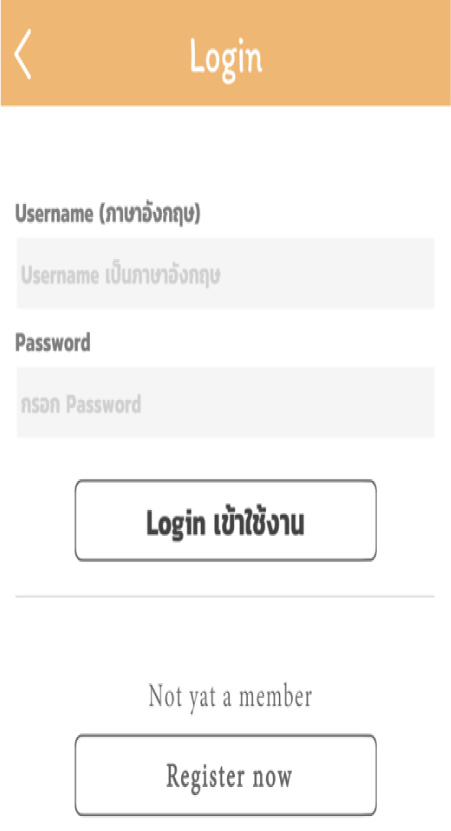
2. Enter the Mind-Counseling application and, from there, subscribe new members.
3. Supply the following requested information completely. Then select “I have entered all information.”
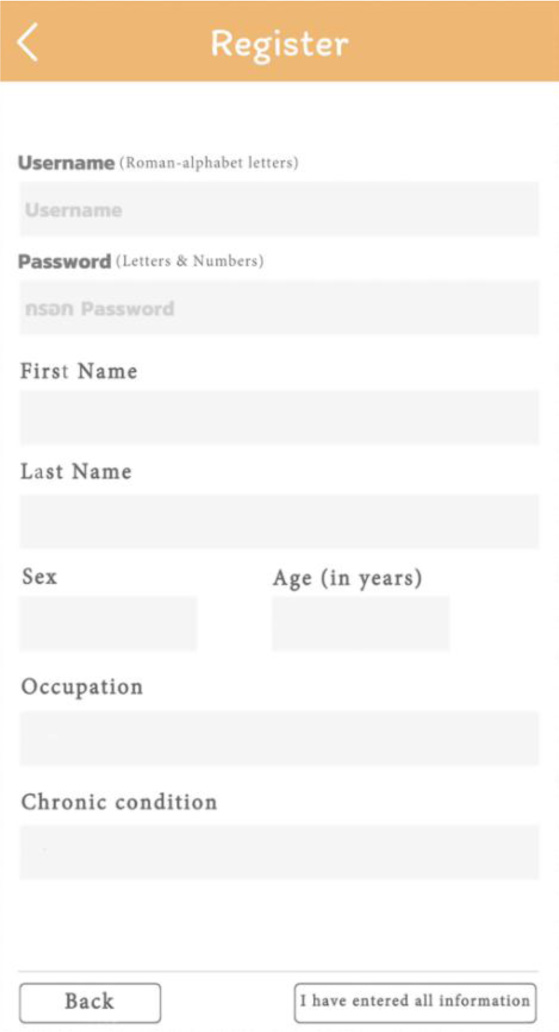
4. The system will lead the volunteers to the first page of the program, which will allow you to choose the menu Those times when I am happy.
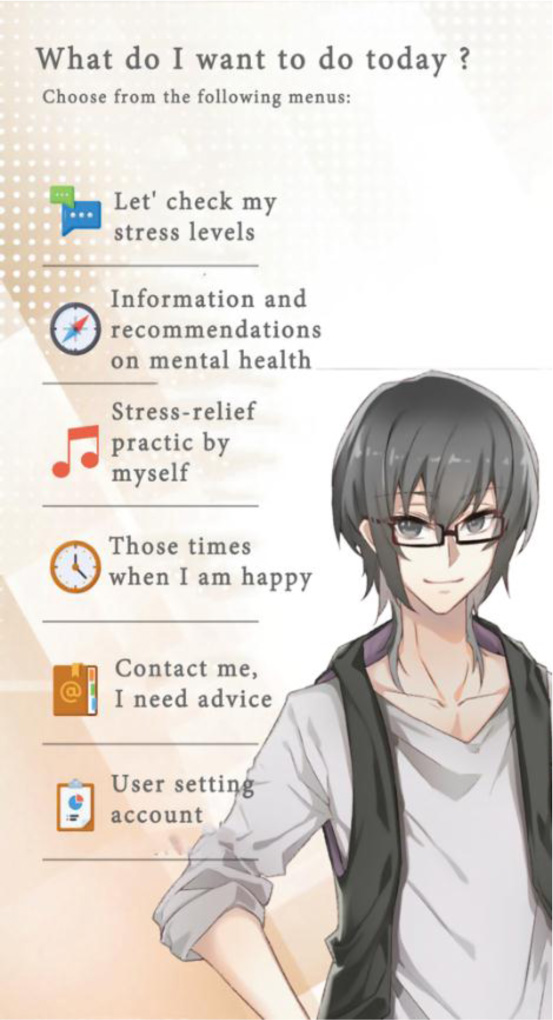
5. Set a time and notification message to devote a block of time to the enhancement of your imagination, which you will be practicing every day, once a day, for about 10-15 minutes. Then select: “Confirm Notification.”
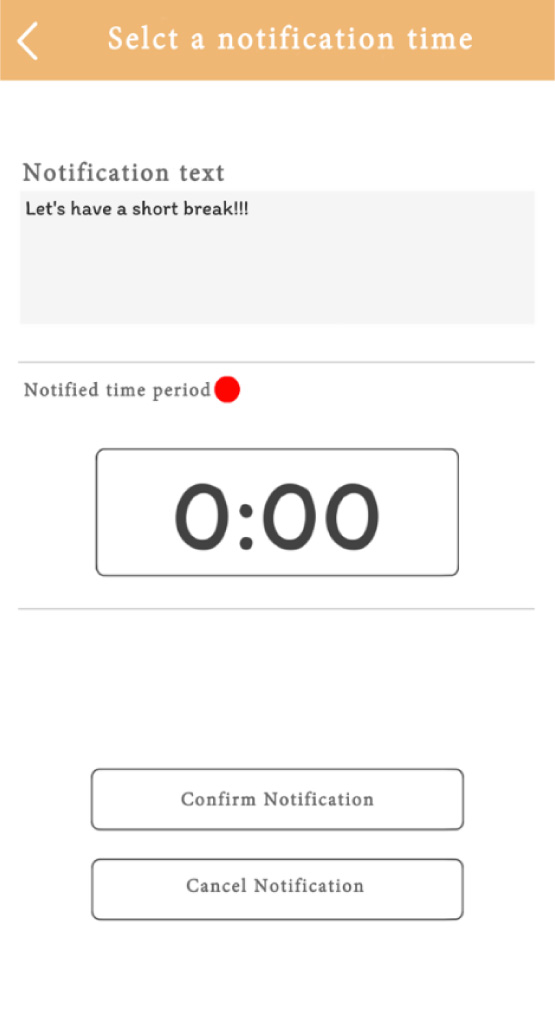
6. When the specified time arrives, the system will alert you on your mobile device. You will then enter the Mind-Counseling application. On the first page, select “Stress-relief practice by myself.”
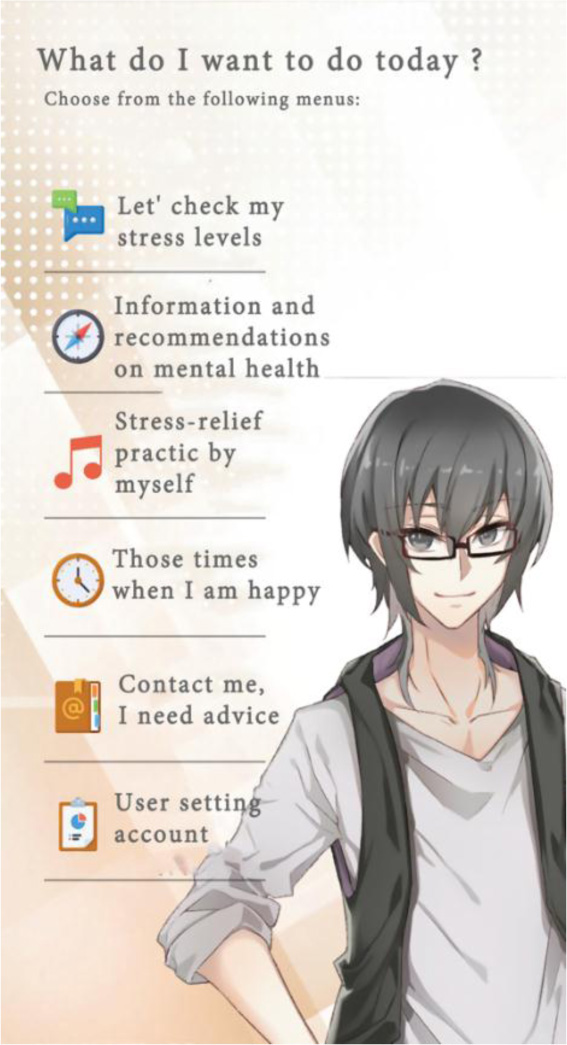
7. At this point, begin practicing the enhancement of your imagination. Continue to practice it for 14 days in a row.
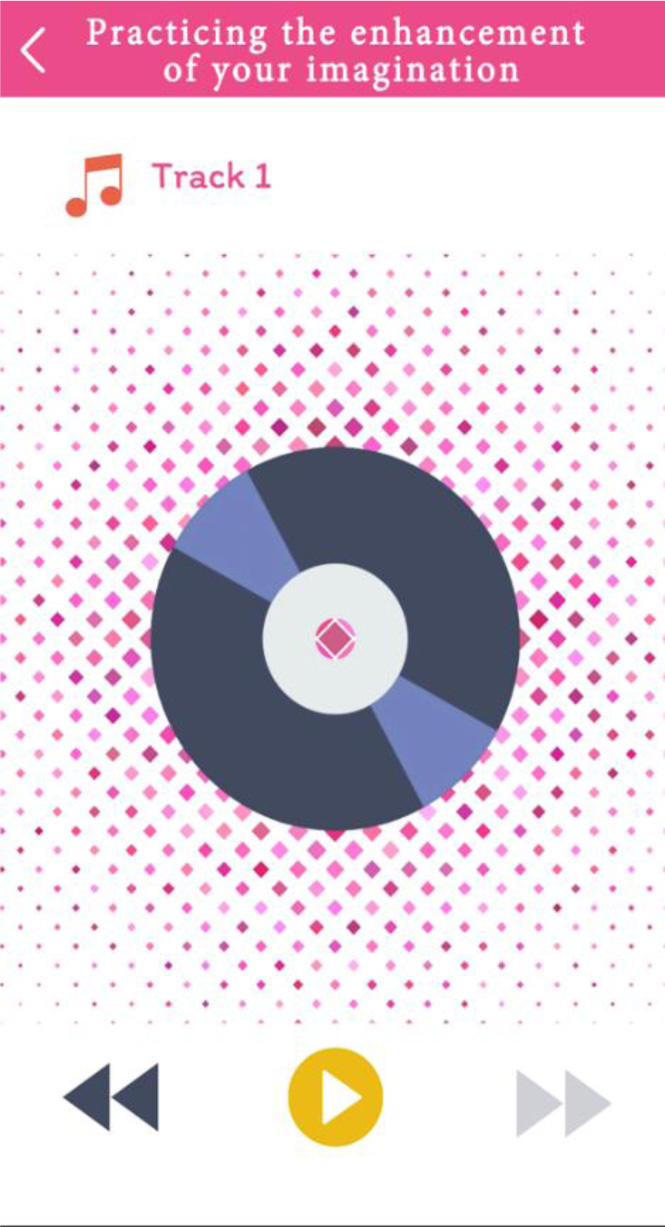
3.4. The Instrument used in Compiling the Data
The Thai Stress Test of Phattharayuttawat et al. (2000, pp. 248-249) features a stress-measurement test intended specifically for the people of Thailand. It is a measurement format that evaluates trends in stress loads at different levels and has an evaluation feature in the form of a three-level Likert scale of never feeling stressed, feeling stressed occasionally, and feeling stressed quite often. It consists of multiple-choice questions to which the respondent chooses the answers that match his or her own feelings in the moment. It is divided into two sections: questions 1-12 refer to negative feelings, and questions 13-24 refer to positive feelings. Cronbach’s alpha used for reliability was 0.88, exceeding the index of 0.7 [29].
3.5. Data Analysis
1. The descriptive data analysis of the sample groups took the form of frequency distribution, percentages, average values, and standard deviation.
2. Repeated measures MANOVA and a post-hoc comparison were carried out to compare the averaged stress values of the experimental group with the control group during three separate time frames: (1) pre-experimentation, (2) post-experimentation, and (3) two-weeks post experimentation. SPSS version 22 was used for the data analysis, separated as follows.
4. RESULTS
4.1. Primary Information
The base data of the sample of 54 people divided into control and experimental groups of 27 each revealed that the majority of students in both groups had a close family relationship (96.30%), and the students and their families had no history of severe physical or mental illness (100%). The average age of the students in the control and experimental groups was 19.67 (SD = 0.62) and 20.89 (SD = 0.89) (Table 1).
An overall analysis of the stress variables, which were sub-classified into the two areas of negative feelings and positive feelings that were experienced by the experimental group and the control group during the three time frames, led to the following findings.
1. In the area of negative feelings, the overall average scores prior to joining the program of the control group and experimental group were similar, such that Mcontrol = 11.81 and Mexperimental = 11.37. Additionally, when the beginning stages were taken into account, it was found that the average overall scores after joining the program of the control group were higher than those of the experimental group, both before and after joining the program on imagination enhancement.
2. In the area of positive feelings, the overall average scores both before and after joining the program of the control group and the experimental group were similar during the time frame, as shown in Table 2.
4.2. Comparative Analysis of Average Stress
Stress comparisons both before and after joining the program for enhancing the imagination through use of a mobile app and monitoring the results two weeks after conclusion of program participation
A comparative analysis of nursing-student stress loads both before and after entering the above-mentioned program took the form of a data collection that was carried out in three stages, namely (1) prior to program entrance, (2) at the conclusion of the program, and (3) two weeks after program conclusion. Two stress-related variables were involved in the analysis: negative feelings and positive feelings. The stress variables were analyzed using one-way repeated ANOVA, as separated by negative and positive feeling.
|
Group Demographic data |
Control (n=27) | Experimental (n=27) | Test | ||||
|---|---|---|---|---|---|---|---|
| Cluster variable | frequency | percentage | frequency | percentage | χ2 | p-value | |
| 1) Family relationship: | |||||||
| Close relationship | 26 | 96.30 | 26 | 96.30 | 0.00 | 0.75 | |
| Conflict relationship | 1 | 3.70 | 1 | 3.70 | |||
| 2) Family status | |||||||
| Married | 19 | 70.37 | 17 | 62.96 | 0.33 | 0.39 | |
| Divorced | 8 | 29.63 | 10 | 37.04 | |||
| 3) History of physical or mental illness | |||||||
| Yes | 0 | 0.00 | 0 | 0.00 | - | ||
| No | 27 | 100.00 | 27 | 100.00 | |||
| Continuous variable | M | SD | M | SD | t | p-value | |
| 5) | Age | 19.67 | 0.62 | 20.89 | 0.89 | 5.85 | <0.001 |
| Stress variables | Control group (n=27) | Experimental group (n=27) | ||||||
|---|---|---|---|---|---|---|---|---|
| Min | Max | M | SD | Min | Max | M | SD | |
| Negative feelings | ||||||||
| Stage 1: prior to joining the program | 7.00 | 20.00 | 11.81 | 3.78 | 8.00 | 16.00 | 11.37 | 2.79 |
| Stage 2: end of program participation | 7.00 | 18.00 | 11.26 | 2.74 | 2.00 | 19.00 | 9.04 | 4.38 |
| Stage 3: two weeks after program conclusion | 4.00 | 17.00 | 10.63 | 3.10 | 0.00 | 17.00 | 9.11 | 4.16 |
| Positive feelings | ||||||||
| Stage 1: prior to joining the program | 11.00 | 36.00 | 23.93 | 7.63 | 12.00 | 36.00 | 23.00 | 6.39 |
| Stage 2: end of program participation | 16.00 | 31.00 | 24.93 | 3.72 | 11.00 | 36.00 | 24.96 | 6.61 |
| Stage 3: two weeks after program conclusion | 16.00 | 34.00 | 25.07 | 4.25 | 11.00 | 36.00 | 25.19 | 6.75 |
4.2.2. Comparative Analysis of Average Negative Feelings
The negative feelings experienced by the nursing students in the group that participated in the program for enhancing their imagination through the use of a mobile app were compared for analysis with the group that did not participate, carried out in three time frames: (1) prior to entering the program; (2) at the conclusion of the program; and (3) at two weeks after program conclusion. The testing for compound symmetry using Mauchly’s test of sphericity classified the significant difference at 0.05 (p = 0.001). The statistical values using the Greenhouse-Geisser test showed the difference in negative feelings among the time frames at a statistical significance of 0.05 (F = 4.946, p = 0.014), as seen in Table 3.
Upon examining the comparative differences in the negative feeling among the three time frames, it was discovered that the overall scores for the average negative feeling of the control group did not differ in any of the three time frames, while the experimental group had a paired difference—that is, feelings of negativity both before and after entering the program for the enhancement of imagination through the use of the mobile app at a statistically significant difference of 0.05 (p = 0.005). Further, the nursing students had feelings of negativity prior to entering the program; at the conclusion of the program and during the second week after concluding participation in the program differed with a statistical significance of 0.05 (p = 0.028), as can be seen in Table 4 and Fig. (2).
| Source | Type III sum of squares | df | Mean square | F | P-value | Partial eta squared |
|---|---|---|---|---|---|---|
| Time | 92.333 | 1.625 | 56.825 | 4.946 | 0.014 | 0.087 |
| Time * group | 21.642 | 1.625 | 13.319 | 1.159 | 0.310 | 0.022 |
| Error (Time) | 970.691 | 84.494 | 11.488 |
| Group | Time | Mean difference (I-J) | Std. error | P-valueb | 95% Confidence interval for differenceb | ||
|---|---|---|---|---|---|---|---|
| Lower bound | Upper bound | ||||||
| Control | 1 | 2 | 0.556 | 0.805 | 0.493 | -1.061 | 2.172 |
| 3 | 1.185 | 0.999 | 0.241 | -0.820 | 3.190 | ||
| 2 | 3 | 0.630 | 0.654 | 0.340 | -0.682 | 1.942 | |
| Experiment | 1 | 2 | 2.333 | 0.805 | 0.005 | 0.717 | 3.949 |
| 3 | 2.259 | 0.999 | 0.028 | 0.255 | 4.264 | ||
| 2 | 3 | -0.074 | 0.654 | 0.910 | -1.386 | 1.238 | |
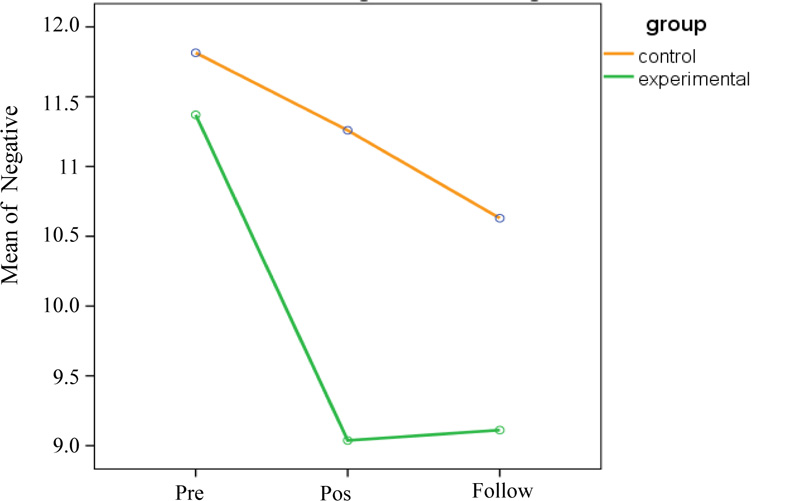
| Source | Type III sum of squares | df | Mean square | F | Sig. | Partial eta squared | |
|---|---|---|---|---|---|---|---|
| Time | 90.123 | 1.542 | 58.430 | 2.396 | 0.110 | 0.044 | |
| Time * group | 9.037 | 1.542 | 5.859 | 0.240 | 0.729 | 0.005 | |
| Error (Time) | 1956.173 | 80.206 | 24.389 | ||||
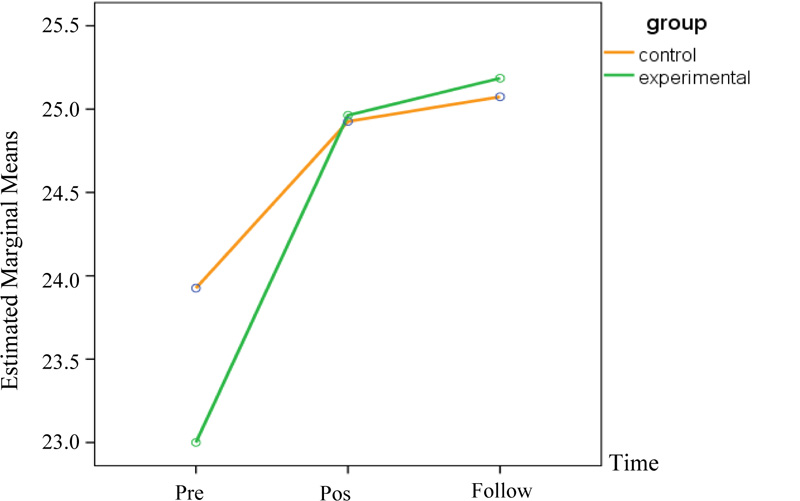
4.2.3. Comparative Analysis of Positive Feelings
The feelings of positivity in nursing students in the group whose members entered the program for enhancing their imagination through the use of the mobile app were compared with those in the group whose members did not enter the program. Comparisons were made during three time frames, namely (1) just prior to entering the program; (2) at the very end of the program; and (3) two weeks after the conclusion of the program using one-way repeated ANOVA. The Mauchly’s test of sphericity classified the significant difference at .05 (p < 0.001). The Greenhouse-Geisser test of positive feelings showed no difference in the total positive feeling scores among the three time frames (Table 5 and Fig. 3).
4.2.4. Comparison of nursing-student stress between groups
4.2.4.1. Negative feelings
An analysis was carried out comparing the negative feeling between the groups. It was found that the scores of the control group and the experimental group differed with a statistical significance of 0.05 (F= 4.104, p = 0.048). After the program, the average scores of the control and experimental groups were different with a statistical significance of 0.05 (mean difference = 2.222, p = 0.030), as seen in Table 6 and Fig. (4).
| Groups | Time | Mean difference (I-J) | Std. error | P-valueb | 95% Confidence interval for differenceb | ||
|---|---|---|---|---|---|---|---|
| Lower bound | Upper bound | ||||||
| Control | Experimental | 1 | 0.444 | 0.905 | 0.625 | -1.371 | 2.260 |
| 2 | 2.222 | 0.994 | 0.030 | 0.227 | 4.218 | ||
| 3 | 1.519 | 0.999 | 0.135 | -0.487 | 3.524 | ||
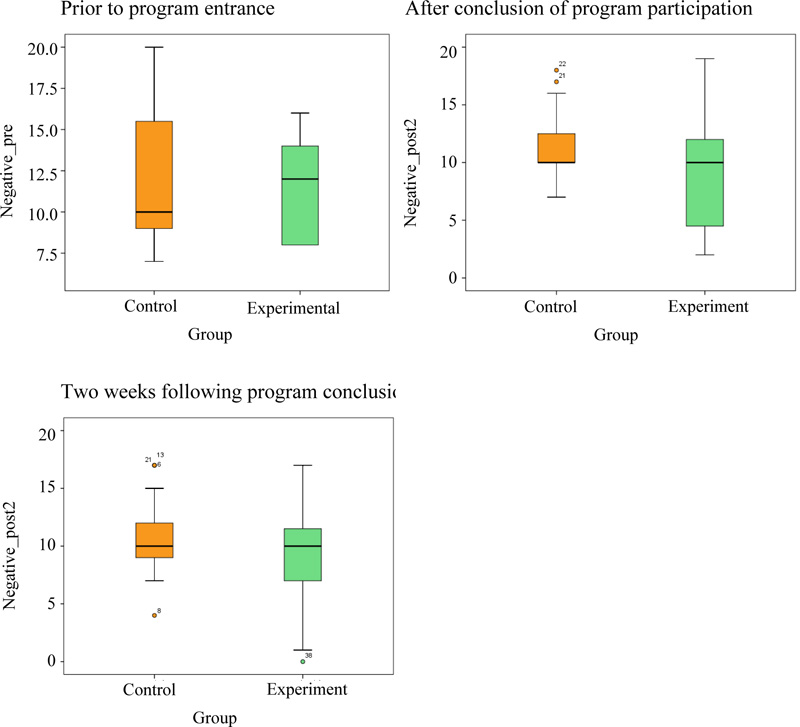
4.2.5. Positive Feelings
The results revealed that mean scores of the control and the experimental group differed without a statistical significance of 0.05 (F=0.038, p=0.847) as seen in Table 7 and Fig. (5).
| Source | Type III sum of squares | df | Mean square | F | P-value | Partial eta squared |
|---|---|---|---|---|---|---|
| Intercept | 97338.525 | 1 | 97338.525 | 1343.163 | 0.000 | 0.963 |
| Group | 2.722 | 1 | 2.722 | 0.038 | 0.847 | 0.001 |
| Error | 3768.420 | 52 | 72.470 |

5. DISCUSSION
The research findings have enabled a discussion on the effectiveness of the program of imagination enhancement through the use of a mobile app on easing nursing-student stress loads. The relevant issues were as follows.
The present study employed a stress-measurement testing device intended for the people of Thailand known as the Thai Stress Test. The defined scale levels are: never feeling stressed, feeling stressed occasionally, and feeling stressed quite often. The test itself consists of multiple-choice questions to which the respondent chooses the answers that match her or his feelings in the moment. It is divided into two sections: questions 1-12 refer to feelings of negativity, and questions 13-24 refer to feelings of positivity. Viewing the specifics of the present study as a division between feelings of negativity and feelings of positivity shows that feelings of negativity before, just after, and two weeks after the conclusion of the program for imagination enhancement differed with a statistical significance of 0.05. This value applied to comparisons both within the experimental and control groups, as well as to comparisons between the two groups. Such are the results obtained from the program on imagination enhancement, which sought to train the experimental group members to use their imaginations to develop a sense of internal peace and happiness, and which should be helpful to the experimental group in reducing whatever feelings of negativity they may be experiencing.
These findings are in agreement with the research results obtained by Kanji et al., who introduced the technique of autogenic training for use in lowering the stress loads of 93 nursing students studying at a university in the United Kingdom. They found that they could lower the stress loads of the nursing students significantly. Furthermore, they were able to lower their blood pressures and heart rates as well [30]. Their technique was based on muscle and breath control, along with imagining a place of peace and contentment. Their work harmonized with the research work of Lim and Kim, who conducted a study of the effect of enhancing the imagination for the purpose of reducing stress and heart rates of 40 nursing students that were in the third year of their studies at two universities. It was found that the stress loads were lowered significantly, while heart rates were not significantly reduced [31].
The mobile application is a communication medium for use in a program for stress-relaxation practice, which is based on autogenic training. It is capable of reducing stress, since it is compatible with the sample group of teenagers and young adults, most of whom are in the habit of using their cell phones for more than four hours each day [32]. This proved to be an alternative way of easing stress, apart from other methods. Its usage features are consistent with the results of a study that proposed a mobile app for easing stress; the app was used in a sample group of 30 people for a period of four weeks and it was found to be capable of reducing stress significantly [33]. Yet, it was found that the average values of the experimental group, whose members were using the program, had increased at two weeks after the conclusion of the program (M = 9.04, SD = 4.38) and were then beyond what they had been when the program had just ended (M = 0.11, SD = 4.16). It is possible, therefore, that after a certain amount of time, stress levels can increase again. Similarly, in a study conducted by Hwang and Jo, it was found that after four weeks, stress levels had increased beyond what they were at the very end of the program [34]. These findings were further verified by a systematic literature review of a study that examined the results of using a mobile app in a sample group that had been afflicted with post-traumatic stress disorder. It was found possible to reduce stress, but there were limitations imposed by the length of time that had elapsed since concluding the experimentation. The stress levels would then rise again [35].
The fact that the stress levels could rise again is only one matter of concern. Use of the Mind-Counseling application requires the payment of a fee in order to download it onto the cell phone where it can then be installed. The price will depend on the service fee of the sample group using it [36] and the memory limitations of the cell phones used by the sample group. It would therefore be necessary to erase some of the data stored in the phones in order to install the program. It was also found that when the members of the sample group in the present opened their phones to run the imagination-enhancement program, there were sometimes other notifications disrupting their practicing. This situation was mirrored in a study on running programs on a cell phone. The study was aimed at reducing anxiety when a notification from a game loaded in the phone interrupts the practice of the sample group yet again [33].
LIMITATIONS
- This study focused on only one nursing school in order to make the teaching program the same for the experimental and control group.
- Most of the samples were female nursing students because in Thailand nursing is more popular among females than males.
- In order to achieve the necessary sample size, the nursing students in all years were included in the study because there were not enough students that exhibited mild stress in each year alone.
CONCLUSION
The findings of the present research illustrate the practical use of technology in providing care for nursing students that are under stress, and that are able to adapt to real-world situations and have aptitude in the use of technology. This technology can therefore be effectively applied to the mental healthcare of nursing students.
ETHICS APPROVAL AND CONSENT TO PARTICIPATE
This research was approved by the Human Research Ethics Committee of Thammasat University (Science Panel) (HREC-TUSc). Project code 204/2561.
HUMAN AND ANIMAL RIGHTS
No animals were used in this research. All procedures performed in studies involving human participants were in accordance withthe ethical standards of the committee responsible for human experimentation (institutional and national), and with the Helsinki Declaration of 1975, as revised in 2013 (http://ethics.iit.edu/ecodes/node/3931).
CONSENT FOR PUBLICATION
Informed consent has been obtained from the participants involved.
STANDARDS OF REPORTING
STROBE guidelines and methodologies were followed.
AVAILABILITY OF DATA AND MATERIALS
The data that support the findings of this study are available on request from the corresponding author.
FUNDING
None.
CONFLICT OF INTEREST
The authors declare that they have no competing interests.
ACKNOWLEDGEMENTS
Firstly, we’d like to express my thanks to Faculty of Nursing, Thammasat University, who has supported us throughout this research project. We are extremely grateful for Faculty of Engineering, Thammasat University guidance and overall insights in this field have made this an inspiring experience for us. We’d also like to thank our participants who took the time to reflect on their consumption experiences.


